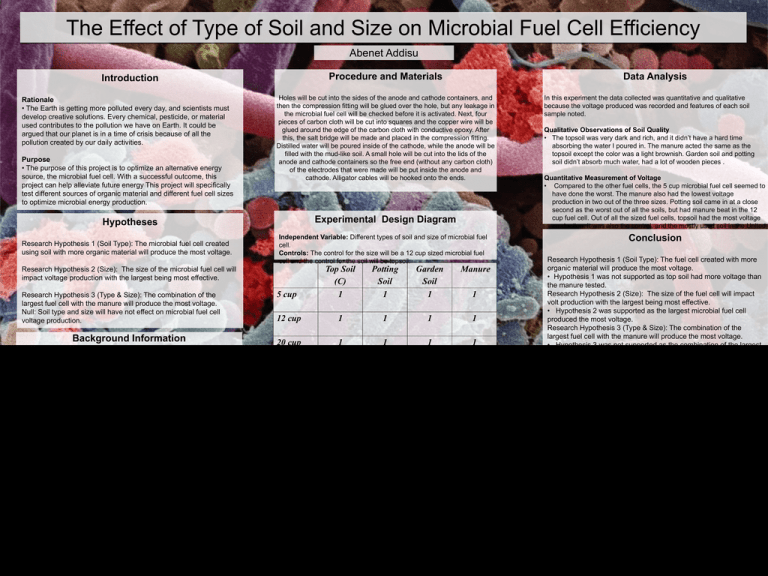Dependent Variable - Type of Soil and Size of a Microbial Fuel Cell
advertisement

The Effect of Type of Soil and Size on Microbial Fuel Cell Efficiency Abenet Addisu Procedure and Materials Introduction Rationale • The Earth is getting more polluted every day, and scientists must develop creative solutions. Every chemical, pesticide, or material used contributes to the pollution we have on Earth. It could be argued that our planet is in a time of crisis because of all the pollution created by our daily activities. Purpose • The purpose of this project is to optimize an alternative energy source, the microbial fuel cell. With a successful outcome, this project can help alleviate future energy This project will specifically test different sources of organic material and different fuel cell sizes to optimize microbial energy production. Holes will be cut into the sides of the anode and cathode containers, and then the compression fitting will be glued over the hole, but any leakage in the microbial fuel cell will be checked before it is activated. Next, four pieces of carbon cloth will be cut into squares and the copper wire will be glued around the edge of the carbon cloth with conductive epoxy. After this, the salt bridge will be made and placed in the compression fitting. Distilled water will be poured inside of the cathode, while the anode will be filled with the mud-like soil. A small hole will be cut into the lids of the anode and cathode containers so the free end (without any carbon cloth) of the electrodes that were made will be put inside the anode and cathode. Alligator cables will be hooked onto the ends. Experimental Design Diagram Hypotheses Research Hypothesis 1 (Soil Type): The microbial fuel cell created using soil with more organic material will produce the most voltage. Independent Variable: Different types of soil and size of microbial fuel cell. Controls: The control for the size will be a 12 cup sized microbial fuel cell and the control for the soil will be topsoil. Potting Soil 1 Garden Soil 1 Manure 5 cup Top Soil (C) 1 12 cup 1 1 1 1 20 cup 1 1 1 1 Research Hypothesis 2 (Size): The size of the microbial fuel cell will impact voltage production with the largest being most effective. Research Hypothesis 3 (Type & Size): The combination of the largest fuel cell with the manure will produce the most voltage. Null: Soil type and size will have not effect on microbial fuel cell voltage production. Background Information Independent Variable • This project has two independent variables which are the size of the microbial fuel cell and the type of soil inside the fuel cell. • Three fuel cells will be designed that hold 5, 12, and 20 cups of organic material. Each of these designs will be tested with the different soil types. Data Analysis 1 Constants: The anode, cathode, external circuit, the PEM, the amount of soil and water put into each trial. Dependent Variable: Voltage produced. Qualitative Observations of Soil Quality • The topsoil was very dark and rich, and it didn’t have a hard time absorbing the water I poured in. The manure acted the same as the topsoil except the color was a light brownish. Garden soil and potting soil didn’t absorb much water, had a lot of wooden pieces . Quantitative Measurement of Voltage • Compared to the other fuel cells, the 5 cup microbial fuel cell seemed to have done the worst. The manure also had the lowest voltage production in two out of the three sizes. Potting soil came in at a close second as the worst out of all the soils, but had manure beat in the 12 cup fuel cell. Out of all the sized fuel cells, topsoil had the most voltage production. It was also the control, and the mostly used soil in the United States. Conclusion Research Hypothesis 1 (Soil Type): The fuel cell created with more organic material will produce the most voltage. • Hypothesis 1 was not supported as top soil had more voltage than the manure tested. Research Hypothesis 2 (Size): The size of the fuel cell will impact volt production with the largest being most effective. • Hypothesis 2 was supported as the largest microbial fuel cell produced the most voltage. Research Hypothesis 3 (Type & Size): The combination of the largest fuel cell with the manure will produce the most voltage. • Hypothesis 3 was not supported as the combination of the largest with topsoil produced the most voltage. Null: Soil type and size will have not effect on microbial fuel cell voltage production. Future Research • Expanding on the independent variables could be tested to discover the limit of microbial fuel cells. Instead of testing which soil produced the highest output of electricity, getting more specific and testing different bacteria will help with results. Dependent Variable • The dependent variable in this experiment is the amount of voltage produced from each type of soil and size of a microbial fuel cell. Voltage was measured in this experiment because it’s also used to determine the electric potential difference between the two points that create the current. • It was measured by attaching a multimeter to the wires from the anode and cathode. It was measured in volts. The pictures above show the 20 cup fuel cell being tested with top soil. This arrangement produced the most energy. Photos by In this experiment the data collected was quantitative and qualitative because the voltage produced was recorded and features of each soil sample noted. Bibliography The figure above shows voltage production of the four types of soils along with the three sized microbial fuel cells. • EAIS. (2010). Types of soils. Retrieved from http://www.eais.net/soil/#1 • Gav, B. (2006, May 23). Peak Energy. Retrieved April 13, 2011, from Blogspot: http://peakenergy.blogspot.com/2008/05/dirt-powered-fuelcells.html •Harper, G. (2008). Fuel Cell Projects for the Evil Genius. Los Angeles: McGraw Hills. • Liu, H. (2004). Electricity Generation Using an Air-Cathode Single Chamber Microbial Fuel Cell in the Presence and Absence of a Proton Exchange Membrane. Environmental Science and Technology .









